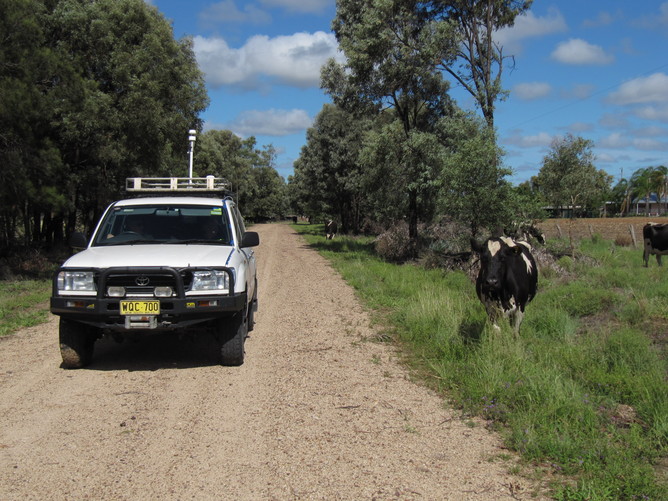CSIRO through the Gas Industry Social and Environmental Research Alliance (GISERA) is undertaking a comprehensive study of methane seeps in the Surat basin.
Our scientists are taking to the sky above the Surat basin in south-west Queensland to answer a big question – is coal seam gas (CSG) green?
Not literally green, of course: CSG is invisible to the naked eye. What we’re actually looking to determine is the CSG industry’s greenhouse gas footprint. The industry is set to increase production in Australia in coming years, so it’s important to be able to adequately monitor current and future CSG developments and provide information that will help limit any potential environmental impact.
Measuring methane seeps.
A four wheel drive-mounted methane detector, with onlookers.
One way to determine the CSG industry’s greenhouse gas footprint is by measuring methane seeps. Methane seeps occur naturally from underground, as well as in soils, swamps and rivers. Another key component is measuring fugitive methane – methane that leaks from CSG well heads, pipes and other infrastructure. Initial findings show that fugitive methane emissions are lower in Australia than the US.
In south-west Queensland, the Surat basin is where CSG activities are in full swing, with its network of production wells, pipelines, access tracks and warning signs. With CSG development in the basin increasing over the next few years, we are trying to establish the amount – and source – of methane emissions now, so that in the future we can determine what is attributable to natural sources, and what is attributable to CSG activity.
To do this, our scientist are using airborne sensors aboard helicopters to measure natural methane emissions. With this data in hand, they then calibrate and validate it with land-based sensors to identify how much methane naturally occurs from the ground.
Findings from this research will provide a methane emissions data set that can be used to compare against changes in methane emission as CSG production increases; and will add to the bigger picture of assessing the industry’s whole-of-life-cycle greenhouse gas footprint.
For more information, visit GISERA or our website.



15th May 2016 at 5:43 pm
It’s is rather bizarre, that this work is being done after the horse as bolted.
The critical preliminary questions are;
what are the acceptable limits of fugitive emissions;
What are the health and environmental impacts of fugitive emissions;
What enforcement mechanisms and penalties in place to ensure all available measures are deployed to reduce the incidence of fugitive emissions?
27th April 2016 at 1:42 pm
Hello CSIRO,
It would appear Mark Anning has made an important point. It is a matter of professional ethics that research funding should be transparent. A lack of disclosure about research funding suggests a lack of disclosure about research independence. If in fact this research project is funded by private companies who have a clear financial interest in the outcome of the research than that is a conflict of interest. There is no declaration in the blog by the CSIRO that this research is independent of the companies emitting the CSG. This could suggest that CSIRO is acting as a private consultant to the CSG industry and the blog should be read with that in mind.
Could you clarify the following questions for me?
Is CSIRO acting as an entirely independent research body in carrying out any CSG research and is there a conflict of interest by anyone who might for example be on the steering committee, an advisory panel, or the selection committee for the scientists to carry out the research? Who owns the CSG research and who is managing and directing the research?
It would be good if the CSIRO adopted normal social media practice and had a full financial interest disclosure statement at the bottom of each blog. As it happens I do NOT have an interest in land in the Surat basin or the CSG industry.
Thank you for your patience on this important issue and I look forward to your response.
kind regards